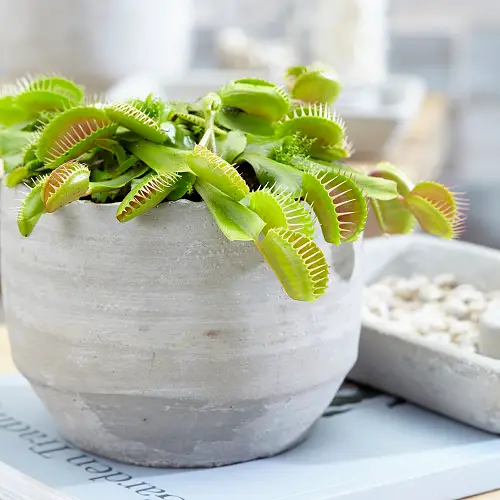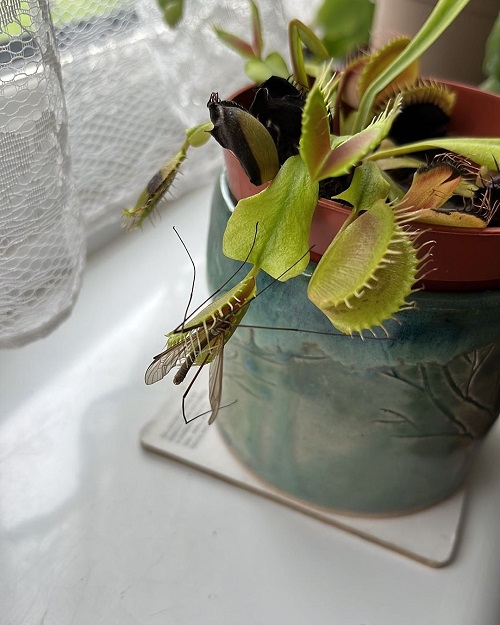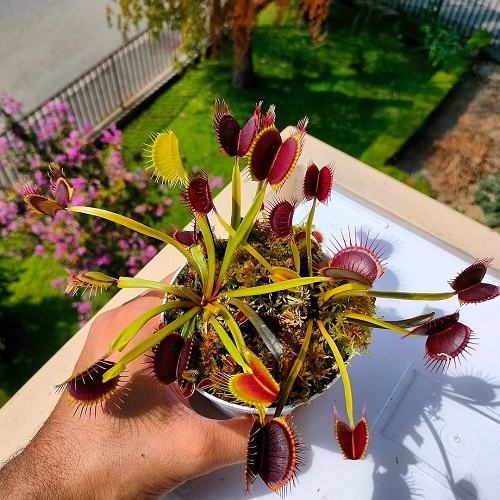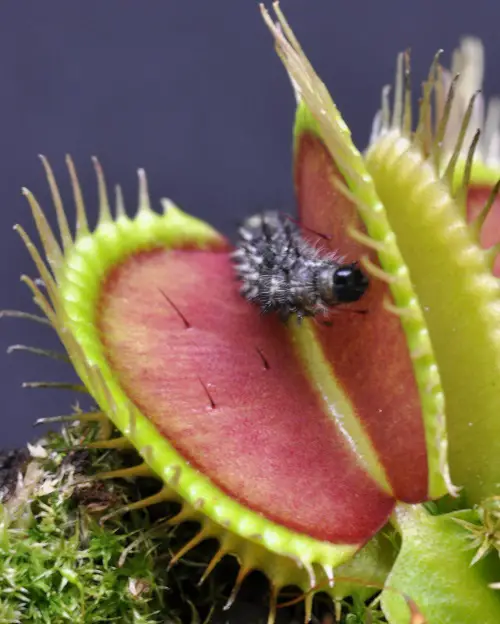Venus Fly Trap Food choices can make or break the health of the plant. Here’s a detailed guide on What to Feed a Venus Fly Trap.

Are you captivated by the almost otherworldly allure of Venus Flytraps but unsure what to feed these carnivorous marvels? Feeding a Venus Flytrap is not just a matter of dropping any insect into its snapping jaws; it’s a fascinating blend of science and natural spectacle. Stick around as we unveil the secrets of Venus Fly Trap Food, debunk common myths, and guide you on how to keep your predatory plant not just alive, but thriving.
Venus Fly Trap Food: What Does It Eat?

1. Insects
- Common Prey: Flies, ants, and small beetles are typical victims.
- Occurrence: Occasionally
- Purpose: To supplement nutrients not available in its native soil, primarily nitrogen.
2. Arachnids
- Common Prey: Spiders
- Occurrence: Less frequently than insects
- Purpose: To acquire additional nutrients
3. Small Aquatic Organisms
- Common Prey: Protozoa and tiny aquatic insects
- Occurrence: Rare
- Purpose: Additional nutrient source, particularly when grown in aquatic settings.
Carnivorous Plant Terrarium Ideas | Carnivorous Plants For Terrariums
Venus Fly Trap – Mechanism of Consumption
1. Trigger Hairs
- The plant’s leaves contain sensitive trigger hairs.
- Two quick touches or one prolonged touch activates the trap.
2. Closing the Trap
- Upon activation, the leaf trap closes in less than a second.
3. Digestive Process
- The trap seals tightly, and digestive enzymes are secreted to break down the prey.
- Nutrients are then absorbed by the plant.
Check out Weird Fly Eating Plants & How To Grow Them here
Energy Source: How Does Venus Fly Trap Survive

1. Photosynthesis
- Like other plants, Venus Fly Traps perform photosynthesis to produce glucose, which serves as their primary energy source.
- Sunlight, water, and carbon dioxide are essential for this process.
2. Nutrient Absorption
- The digestion of prey provides essential nutrients like nitrogen, phosphorus, and potassium, which are lacking in their natural habitat.
- These nutrients support plant growth and development but are not the plant’s main energy source.
What to Feed a Venus Fly Trap
Owning a Venus Fly Trap as a houseplant is both fascinating and rewarding. However, ensuring that it receives the proper nourishment can be a bit tricky. Below are some options for feeding your Venus Fly Trap to keep it healthy and thriving.
1. Live Insects
- Examples: Flies, ants, small beetles
- Frequency: Every 1-2 weeks
- Notes: Live insects are the most natural food source. However, the insect must be small enough to fit within the trap without protruding.
2. Pre-killed Insects
- Examples: Dead flies or freeze-dried crickets
- Frequency: Every 1-2 weeks
- Notes: Convenient but requires manual stimulation of the trap to mimic a live insect’s movements for effective digestion.
3. Fish Food Pellets
- Examples: Betta or goldfish pellets
- Frequency: Every 2-3 weeks
- Notes: Use sparingly and hydrate the pellet first. Like pre-killed insects, you’ll need to stimulate the trap for digestion.
4. Bloodworms
- Examples: Freeze-dried or frozen
- Frequency: Every 2-3 weeks
- Notes: Rehydrate before use. Ideal for younger or smaller traps.
5. Water
- Frequency: As needed for soil moisture
- Notes: While not a food source, using distilled, rain, or reverse-osmosis water is crucial to prevent mineral buildup that can harm the plant.
Venus Fly Trap – What Not to Feed
- Meat: Avoid feeding it pieces of hamburger or other types of meat.
- Human Food: Sugars, salts, and fats from human food can harm the plant.
- Large Insects: An oversized insect can cause the trap to rot.
Feeding Tips
Natural vs. Manual Feeding
- Outdoor Feeding: If the plant is outdoors, it will typically catch enough insects on its own.
- Indoor Feeding: When kept indoors, you may need to feed it manually every 2–4 weeks.
Feeding Procedure
- Preparation: Use tweezers to handle the insect, ensuring it’s alive for optimal results.
- Placement: Gently place the insect in the trap and stimulate the trigger hairs to close the trap.
- Check: The trap should completely close within a few seconds. If not, the plant may not be healthy or the insect may be too small.
Learn How Earthworms Help The Soil here
Post-Feeding Care
- No Overfeeding: One insect is sufficient for one trap. Overfeeding can lead to the plant’s decline.
- Monitor: Make sure the insect is fully consumed and that the trap reopens after about a week.
Feeding Frequency
- Adult Plants: Feed one trap every 2–4 weeks.
- Young Plants: Stick to smaller insects and feed every 3–6 weeks.
Do You Need to Fertlize Venus Fly Trap
Venus Fly Traps generally do not need and are sensitive to most fertilizers.
- Type: If you must fertilize, use a diluted, balanced liquid fertilizer (1/4 of the recommended strength).
- Application: Apply sparingly to the roots, avoiding the traps. Some growers recommend foliar feeding by lightly misting the leaves.
- Frequency: Limit fertilization to once during the growing season, usually in spring.




